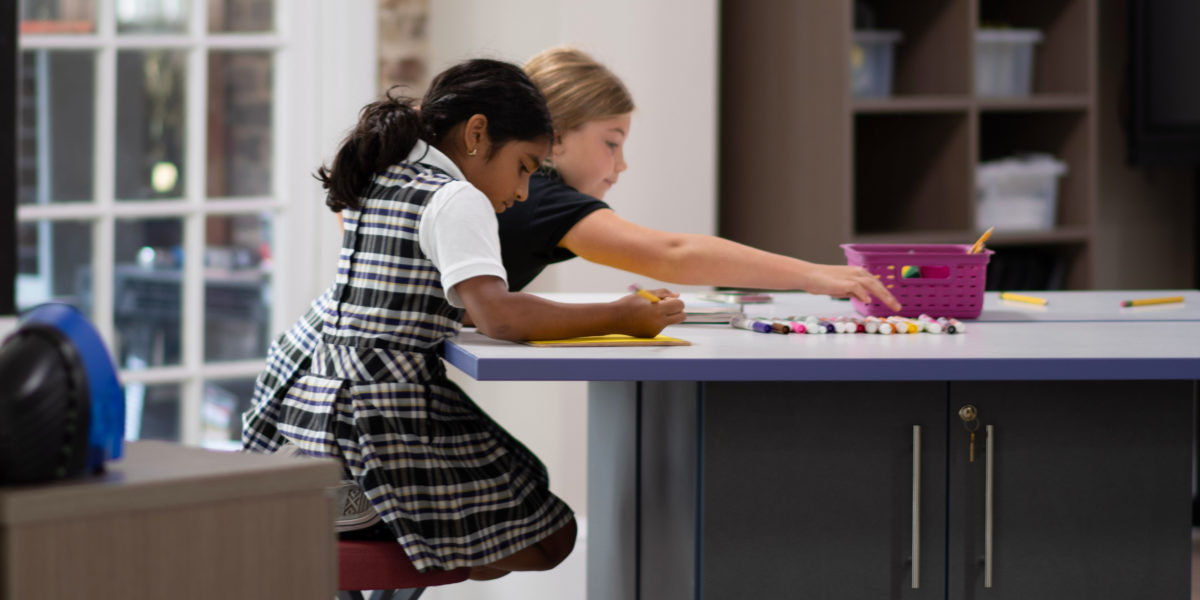
Research shows that if girls do not develop interests in science, technology, engineering, arts, or math (STEAM) before or during their middle school years, they will most likely avoid future classes and careers in these areas altogether. At Ashley Hall, STEAM activities are an integral part of the Lower School curriculum to give girls the chance to fall in love with STEAM–and they don’t just happen in the classroom.
Science and math start inside the classroom and are a large part of students’ core studies. But students get a secondary layer of learning outside of the classroom by attending weekly enrichment classes designed to apply their new math and science concepts. Once a week, students also come together as an entire grade for a special STEAM class. “We do hands-on science and hands-on math to enrich what they’re doing in class,” says Lower School STEAM and science teacher Meghan Ward. “It’s seeing those skills that students are practicing, and saying, ‘Now let’s put it in place in the lab.’ It’s actually really cool to see both disciplines.”
Last month, the School opened a brand-new beautifully renovated 2,100-square foot Lower School STEAM Lab designed to host these enrichment lessons. Inside are stations for experiments, moveable furniture, risers for presentations, a sound-proof room for break-out teacher instruction, and so much more. But the added space and state-of-the-art tools for hands-on experiments and collaboration is just the start of how the STEAM education is evolving at Ashley Hall.
More Space, More Collaboration
Research by UNICEF shows that studying STEAM helps girls develop skills in collaboration and self-development which gives girls tools with which to become informed citizens and effective leaders. The new Lower School STEAM Lab, which can support a whopping four classes at one time, was designed specifically to be able to support the opportunity for girls to work together.
“Why STEAM is so powerful is it is focused on giving the girls a challenge to try and solve a problem,” Ward says. “We always have them begin the process by sketching their own idea, then they collaborate with a group and come up with one design. They always have minimal materials, just a little bit of time, and they have to problem solve. They debate the best design and have to learn how to bring each other together and come up with one idea. But then on the other side, they support each other, too.”
“They’re learning to communicate and be respectful communicators,” adds Lower School Math Specialist Allison Jordan. “It’s hard for them. It’s such a hard skill for anyone to learn. But they are doing it every day.”
A New Perspective on Mistakes
According to the Goodman Research Group, girls’ school graduates are 6 times more likely to consider majoring in math, science, and technology compared to girls who attended coeducational schools. Why?
“We’ve created a safe place to make mistakes so that young girls can learn,” Ward says. “We call them ‘oops-ortunities’ or oopsies that you can turn into opportunities. They happen all the time in STEAM. A student will say something is not working. Okay. So we go back and try again, try it differently.”
The confidence that comes with not being afraid to make mistakes is everything, explains Jordan. “All you need is confidence. We have a lot of tears in the lab. It’s sometimes due to frustration with your team, but a lot of the time it’s because students don’t have the faith in themselves. If they get a math answer wrong, it makes them feel bad. But if they have the confidence to say, oops, I made a mistake, and ask for help, then there goes all that intimidation. That’s my biggest goal in here with math at least is to make them feel safe to figure it out. This is your safe space to make mistakes.”
Integrating a Empathy
Science, technology, engineering, arts, and math are at the core of our STEAM education in Lower School. But as the program continues to grow, so do the pillars of Ashley Hall’s STEAM curriculum. “One of the things we’re adding is the idea of empathy,” Ward says. “Everything we’ve done in STEAM, we’ve encouraged them to think with empathy.”
For example, when Lower School students studied the body, they had to create a stethoscope out of basic materials like cups and paper towel rolls. Then Ward asked the girls a question: Who would use a stethoscope? “We talked about people who take care of us who use stethoscopes. Then I took it a step further and asked if they thought everybody in the world uses a stethoscope. We have great medical devices in our country, but does everyone have that? And what if you lived in a country where they didn’t have stethoscopes and these materials were all you had to work with to hear a baby’s heartbeat? Suddenly, we were talking about real people and real issues in the world.”
And again, research supports just how much of an impact STEAM education for young girls can have on global issues. According to research presented by UNICEF in a report entitled Towards an Equal Future: Reimagining Girls’ Education Through STEM:
“Learning to think and solve problems like scientists and engineers can equip girls with the knowledge, confidence and creativity to address major challenges in their communities, such as generating sufficient energy, preventing and treating diseases, maintaining supplies of clean water and food, and solving the problems of environmental change.”
By adding a focus on collaboration, confidence, and empathy throughout every level of STEAM education in the Lower School, Ashley Hall is creating not only future scientist and engineers, but girls equipped to be the best version of themselves.
